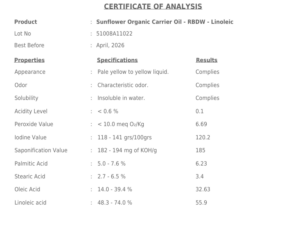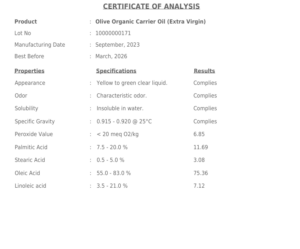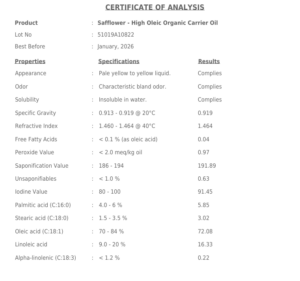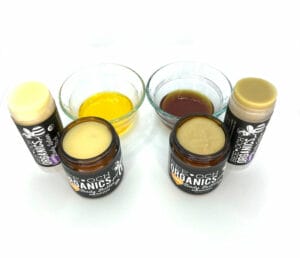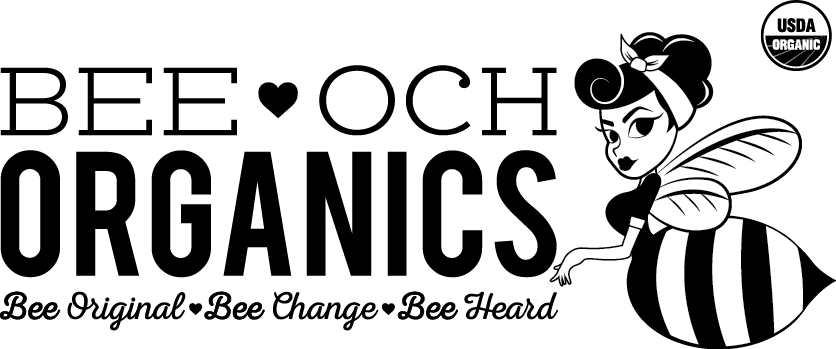Hey there, it’s Brooke (Queen BEE-OCH) to weigh in on seed oils (specifically in skincare)! Originally, I wrote this in response to an email from a friend, client, and functional nutritionist in training who inquired about seed oils in topical applications. As a quick background, seed oils have recently gained a bad rap on the internet with claims that they are unhealthy due to the process of refinement and being a contributor of inflammation in our bodies.
With the recent online debates about seed oils, many influencers are using their platforms as a chance to be health experts. But despite the hype, what’s really going on with seed oils? And what’s the difference between consuming seed oils VS applying topically? Let’s separate fact from fiction by exploring what the science actually tells us about seed oils in topical applications.
Understanding Seed Oils and Inflammation in Diet
Evidence suggests that seed oils (high in omega-6 Poly Unsaturated Fatty Acids) on their own do not produce an inflammatory response unless they are consumed in an unbalanced ratio of omega-3 fatty acids (1) and consumed along with known inflammatory foods such as lectins, GMOs (and therefore likely infused with RoundUp), and grain-fed animal products (2). Unfortunately, this describes the current American diet for most. What immediately comes to mind is a chicken nugget – a big ol’ inflammation bomb, in my opinion.
Verdict: Seed oils aren’t the bad guys here; it’s the standard American diet that needs the real microscope.
The Healing Properties of Linoleic Acid
I often talk about ingredients such as Vitamin C and Retinol’s ability to induce cell turnover by mimicking an injury (and increasing blood flow and nutrients to the more superficial layers) – that’s how they promote collagen production in the skin (5). Ironically, Linoleic acids (omega-6 PUFA found in seed oils) are shown to increase the rate of wound healing in the skin by moderating the action of the inflammatory response in neutrophils and macrophages (these are your immune cells). LA also works by stimulating angiogenesis (increasing the number of vessels at the wound site) (4).
While internally, this would only be ideal in the case of an actual injury or disease, increasing blood flow, collagen production, and dermal and epidermal cell turnover are the main goals of skincare to promote healthy and healthy-looking skin. Omega 6 PUFAs are able to maximize our skin’s ability to heal and repair itself, which it is in a constant state of (healing and repair) as our body’s suit of armor. Interestingly, LA is also shown to reduce proinflammatory responses in the “resolution” phase of wound healing (4). This means that LA can kick up the repair responses and also facilitate shutting it down. Here’s a great read if you want to see the science of LA in skincare “Omega-6 Fatty Acids: From Inflammation to Regeneration”: https://pmc.ncbi.nlm.nih.gov/articles/PMC5925018/
Verdict: Seed oils are a huge asset in skincare ingredients, providing the essential nutrients for healing and protecting the skin, especially for anti-aging and wound healing purposes.
The Balance of Fatty Acids
Again, because the inflammatory response cannot be left unchecked, the balance of both Omega 6 and Omega 3 fatty acids are important. Seed oils (all oils for that matter) are rarely only one type of fatty acid, but a spectrum of mainly Omega 6, Omega 3, Palmitic, Stearic etc). To this point, research shows that an imbalance of omega 6 and omega 3 consumption in the current American diet is another big reason why it gets a bad rap (entire meals deep fried in GMO canola oil, for example).
Consider the COAs from one of our organic suppliers, side-by-side of Organic Sunflower, Safflower (seed), and Olive Oil (non-seed) oils.
Notice a couple things here:
1. While sunflower has a higher linoleic to oleic ratio, not all seed oils do. Consider that Safflower and Olive Oil have a very similar fatty acid profile.
And 2. As I mentioned above, no oils, whether seed oils or not, contain just one type of fatty acid.
Verdict: That’s why we are super picky about the source of our organic ingredients. Our certified organic suppliers provide full COAs and fatty acid profiles of our ingredients so we can be sure that our ingredients meet both quality and shelf-life standards.
Seed Oils in Skincare: Purpose and Function
Keep in mind that the seed oils we use such as sunflower and safflower are used in products that are meant for healing, restoration, and repair as leave-on ingredients in hand creams, body lotions, and free radical-fighting due to sun exposure (3). The high Linoleic acid content is a huge contributor to their success and efficacy in skin health and repair (8). Whereas other personal care products that are not necessarily meant for healing are made with high-oleic oils, such as Organic Deodorant, Skin Whip, etc.
Verdict: Not all oils are created equal, nor are they all used for the same things. Both seed oils and non-seed oils serve specific purposes, and our skincare products are formulated to serve your skin in the way they naturally do best.
Clarifying “Bleaching” and “Deodorizing”
Nearly all oils must go through a refinement process to make them edible, with the exception of virgin oils, which are typically cold expeller pressed. This process involves either physical or chemical processes to remove impurities such as heavy metals, free fatty acids, waxes, and unwanted by-products, as well as improve color, and smell in the finished product. (6) I think there is also a misconception about what the words “bleaching” and “deodorizing” mean in the oil world (plus a difference in how it’s done in certified organic physical refinement VS conventional practices) (6). Our organic suppliers actually provide flow charts for their extraction processes (pretty awesome!). And although “bleaching” sounds terrible, USDA Organic standards require it to be a mechanical and solventless process to remove color and unwanted smell. Note that even Organic MCT (fractionated coconut oil) goes through the process of fractionation, bleaching, and deodorizing to remove impurities and unwanted by-products. (7)
Check out the difference between deodorized organic pumpkin seed oil (left) and non-refined organic pumpkin seed oil (right):
Not only did almost everyone think that our products made with the non-refined pumpkin seed oil had “gone bad” but believe me when I tell you that the pungent nutty smell of pumpkin seed does not mix well with organic essential oils such as citrus.
Verdict: Refinement is a very important process in oil extraction for human consumption both internally and topically, but not all refinement is created equal. Our USDA Organic Standards require only pure, solventless extraction and refinement, as well as documentation to support the process and the finished product.
The “Rancidity” Concern
Finally, another big argument against seed oils is that the refinement process can remove tocopherols which can cause them to go rancid quickly without their natural antioxidants. This one is funny to me, because anyone who has had any oil sitting in their cupboard too long knows that ALL oils go bad without proper storage or a solid antioxidant system. In fact, most things oxidize without antioxidants. Consider what happens to apple slices or a halved avocado after being exposed to the air for an hour or two – they turn brown! Having worked with oils for the past 10 years, I would actually argue that coconut oil and olive oil go rancid more quickly than seed oils and are super sensitive to both heat and light. However, this is why it isn’t recommended to whip up your skincare in your kitchen, without a proper knowledge of the use of antioxidant ratios and the effect it has on shelf life of the finished product.
Verdict: Don’t buy your skincare from an untrusted source!
The Bottom Line on Seed Oils in Skincare
When properly sourced, extracted, and formulated, seed oils offer significant benefits for skin health through their fatty acid profiles. They support wound healing, strengthen the skin barrier, and contribute to overall skin repair. At BEE-OCH, we carefully select both organic seed and non-seed oils for their specific properties and incorporate them into formulations designed to work in harmony with your skin’s natural processes.
If you have more questions about seed oils or any ingredients in our products, we’re always here to help separate fact from fiction with science-backed information.
Sincerely,
Your favorite nerdy BEE-OCH
References:
(1) Kevin L. Fritsche, PhD. “Linoleic acid, vegetable oils, & inflammation” 2014. https://pmc.ncbi.nlm.nih.gov/articles/PMC6179509/
(2) Gundry SR. The Plant Paradox: The Hidden Dangers in “Healthy” Foods That Cause Disease and Weight Gain. New York: Harper Wave; 2017.
(3) Milady Standard Esthetics: Fundamentals. 11th ed. Clifton Park, NY: Cengage Learning; 2012.
(4) Jéssica R Silva et al. 2018. “Wound healing and omega 6 fatty acids: From inflammation to repair” https://pmc.ncbi.nlm.nih.gov/articles/PMC5925018/
(5) Hayden K. The Science Behind Skincare: A Guide for Estheticians. Independently published; 2020.
(6) Said Gharby. 2022. “Refining vegetable oils: Chemical and physical refinement” https://pmc.ncbi.nlm.nih.gov/articles/PMC8767382/
(7) Effects of chemical refinement on the quality of coconut oil https://pmc.ncbi.nlm.nih.gov/articles/PMC6542917/
(8) Michalun MV, Dinardo JC. Milady Skin Care and Cosmetic Ingredients Dictionary. 4th ed. Clifton Park, NY: Cengage Learning; 2015.


